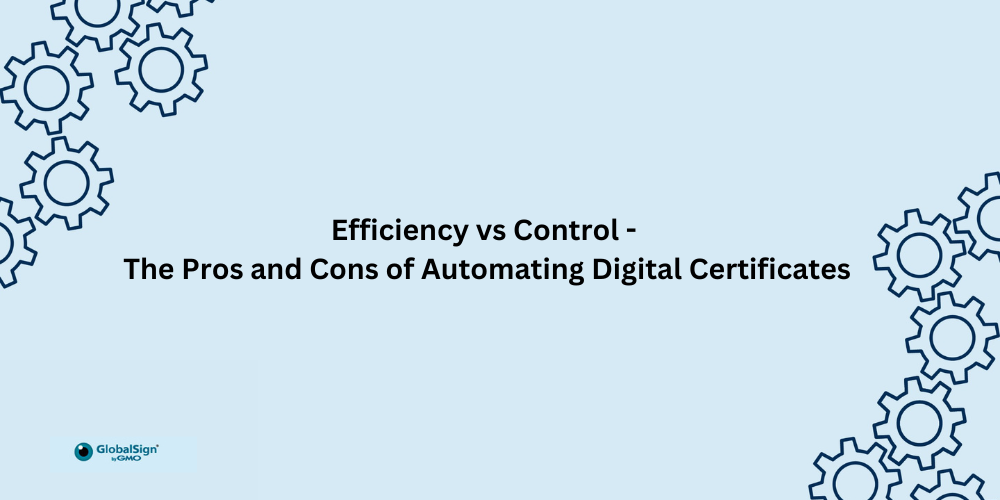
Organizations always seek methods to increase security, improve efficiency, and relieve over-burdened IT resources. With escalating cyber threats and a new year, businesses will benefit from reviewing their digital infrastructure and certificate management practices for potential enhancements to bolster security, time management, and cost efficiencies.
In preparation, it’s an excellent time to consider the pros and cons of digital certificate automation. Evaluating efficiency versus control and security should be critical factors in the decision-making process. Let’s first start with a list of pro automation benefits.
The Pros
Automating digital certificates can bring numerous advantages to an organization, particularly regarding security, efficiency, and compliance. Core benefits include:
Reducing human error – Automation ensures that certificate issuance, renewal, and revocation are carried out consistently. It minimizes the risk of misconfigurations that increase security risks.
Scalability – The number of digital certificates can significantly increase as a business grows. Automation enables IT to manage a large number of certificates without appreciably increasing the workload. It allows security measures to keep pace with business growth.
Efficiency – Digital certificate lifecycles involve tasks requiring time, careful ongoing monitoring, and management accuracy. Automation streamlines these processes, saving time and resources with valuable real-time visibility into the status of certificates. IT and security teams are empowered with proactive management and risk reduction.
Compliance – Adherence to industry standards and regulations is vitally important. Automated systems enforce policy-based certificate issuance and renewal, ensuring certificates meet specific security requirements.
The Cons
While the benefits may be obvious, there are factors that organizations must bear in mind when considering the automation of digital certificates.
The potential for over-automation – If a business has a relatively small number of certificates and reasonably straightforward security needs, overly applying automation could unnecessarily increase costs and complexity.
Initial setup and implementation challenges – Automation systems require expertise in certificate management and the specialized tools used. It necessitates investing time and resources to train or find knowledgeable staff to ensure a seamless integration.
Security – While automation reduces the likelihood of human error, it can introduce potential vulnerabilities in the automated processes. Careful design and monitoring of automated systems is necessary to mitigate these risks effectively.
The Risk of Losing Control with Automated CLM
Automating certificate management could potentially lead to some loss of control. When organizations implement automation, they form reliance upon systems and algorithms to handle critical security components. Suppose the automation components are not selected and implemented correctly. In that case, it may lead to a lack of visibility and understanding of all elements of the certificate lifecycle, potentially introducing unforeseen security vulnerabilities.
Since automated systems use sophisticated algorithms, they could make decisions without human intervention. This could result in certificates being issued, renewed, or revoked in ways that don’t align with established security policies. Also, blind faith in automation processes without the necessary application of human oversight can generate a false sense of security and serious repercussions.
Why You Need to Ask the Experts
Given the potential integration issues and required investment in automating digital certificates, organizations should consult with experts in the field. Experienced consultants can evaluate your organization’s needs and risk profile and provide tailored recommendations. This helps ensure the chosen solution aligns with goals and resources for the right balance between security, efficiency, and cost-effectiveness. Partnering with experts will allow your organization to keep pace with emerging trends and best practices in digital certificate management.
Essential steps to take before automating include:
- Identify what certificates you have
- Analyze the information
- Consult with a trusted Certificate Authority for advice and service options
- Plan the certificates and tasks you would like to automate
- Make incremental changes and evaluate the impact
When Manual Certificate Management Might Be the Best Course
There are situations where manual certificate management might be preferred. As previously stated, for businesses with small certificate portfolios and less complicated security requirements, the benefits of full automation may not justify the associated costs and complexity. In such cases, manual oversight allows for a more hands-on approach, ensuring that every certificate-related decision aligns precisely with the organization’s security policies.
Manual management can also be preferable in highly sensitive or regulated environments where a human touch is valued for critical decisions. Additionally, during initial implementation or significant transitions, organizations might opt for manual processes to better understand the intricacies of certificate management before fully committing to the introduction of automation.
The Potential Cost of Not Automating
Significant operational costs can be associated with manual processes, such as the time spent on certificate issuance, renewal, and revocation. Manual management can lead to delays, increased workload, and potential errors, all contributing to financial deficits. Relying solely upon manual management can result in missed certificate renewals or expirations, leading to downtime or security breaches. The manual tracking of certificates can become overwhelming, especially as the number of certificates grows, increasing the risk of expired certificates causing service disruptions.
Demonstrating compliance and auditing with manual processes can be time-consuming and error-prone, leading to additional costs associated with regulatory fines or legal consequences in the event of non-compliance.
While upfront costs are associated with implementing and maintaining automated certificate management systems, the long-term savings in terms of operational efficiency, reduced human error, and improved security often outweigh the initial investment. Organizations must carefully weigh these factors when deciding whether to automate their digital certificates.
Choosing the Right Automation Tool for Your Organization
Selecting an appropriate digital certificate automation tool provider directly impacts the accuracy and effectiveness of the entire lifecycle management process. The right tool should seamlessly integrate with existing systems, provide robust security features, and offer scalability to accommodate the organization’s evolving needs.
Comprehensive digital certificate automation tools enhance visibility, allowing IT and security personnel to proactively monitor and respond to potential security threats. Ultimately, the careful selection of a digital certificate management automation tool is an investment in the overall resilience and reliability of an organization’s cybersecurity infrastructure. By partnering with experienced digital certificate automation experts, organizations can use the right tools to strike a balance between enhanced efficiencies and the necessary degree of human oversight control.
Not sure where to start with certificate automation, use our free self- assessment tool here https://bit.ly/48iFukT
Editor’s note: This article is sponsored by GlobalSign






